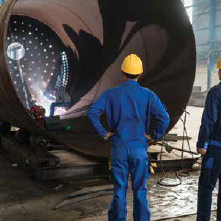Cutting-edge Approaches to Fillet Weld Evaluation and Screening: Enhancing Weld High Quality and Conformity Requirements
In the realm of welding, the high quality and honesty of fillet welds play a crucial role in guaranteeing the architectural strength and integrity of various commercial parts. With the constant drive for improved efficiency and compliance with rigorous criteria, the expedition of cutting-edge techniques to fillet weld inspection and testing has actually come to be imperative. As industries evolve, the traditional methods might no more be sufficient in satisfying the demands of modern-day welding applications. By welcoming innovative innovations and methodologies, a brand-new horizon of possibilities arises in the realm of weld quality analysis and adherence to conformity standards.
Advanced Non-Destructive Testing Approaches
Utilizing modern innovations, progressed non-destructive testing techniques play a crucial function in ensuring the stability and quality of fillet welds. These techniques, such as phased array ultrasonic testing (PAUT) and magnetic fragment screening (MPT), offer in-depth insights into the weld's inner structure without triggering any kind of damage to the material. PAUT, as an example, utilizes several ultrasonic components to inspect the weld from different angles, giving a comprehensive visualization of prospective flaws like lack of fusion or fractures.
By utilizing these sophisticated non-destructive screening methods, weld examiners can precisely examine the high quality of fillet welds, making certain compliance with sector criteria and policies. The capability to identify imperfections early on not just boosts weld top quality yet additionally stops costly rework or failures in structural integrity, underscoring the importance of these innovative testing strategies in welding examinations.
Robotics and Automation in Inspection
The combination of robotics and automation has changed the evaluation process for fillet welds, enhancing efficiency and precision in high quality analysis. Robotics provide precise control and repeatability in evaluating welds, guaranteeing reputable and consistent outcomes. Automated systems can be programmed to comply with specific assessment paths, making sure thorough protection of welds and reducing the danger of human mistake.
Robotic assessment systems equipped with sophisticated sensing units can discover and gauge weld features with high precision, giving comprehensive information for analysis. These systems can determine issues such as cracks, lack of blend, and porosity, enabling timely rehabilitative actions to be taken. In addition, robotics and automation permit real-time information collection and analysis, offering prompt feedback to operators and promoting quick decision-making processes.
Moreover, using robotics and automation in fillet weld evaluation enhances total productivity by minimizing examination times and increasing evaluation throughput. By enhancing the inspection process, makers can ensure weld high quality and compliance requirements are satisfied effectively, inevitably leading to cost savings and improved item top quality.
Making Use Of Expert System for Analysis
Synthetic intelligence plays an essential function in enhancing the performance and precision of analysis in fillet weld examination procedures. AI algorithms can swiftly refine huge amounts of information from weld evaluations, spotting problems or disparities that may be testing to determine with the naked eye - Welding Inspection Racine.
Furthermore, AI systems can pick up from previous inspection information, continually enhancing their capability to recognize potential defects and variances in fillet welds. This flexible understanding capacity enhances the overall quality assurance process, reducing the probability of human error and guaranteeing that welds fulfill the called for see criteria. By incorporating expert system into fillet weld evaluation, markets can attain greater degrees of performance, consistency, and compliance in their evaluation methods.
Portable Equipment for On-Site Assessment
 Enhancing area inspection efficiency, the adoption of mobile devices changes on-site analysis processes for fillet welds. These tools offer versatility and comfort, permitting assessors to conduct comprehensive evaluations in numerous areas, consisting of tough or remote settings. Mobile devices such as ultrasonic screening tools, weblink magnetic fragment examination tools, and electronic radiography systems give real-time information and high-resolution imaging capacities, making it possible for fast decision-making and instant comments on weld high quality.
Enhancing area inspection efficiency, the adoption of mobile devices changes on-site analysis processes for fillet welds. These tools offer versatility and comfort, permitting assessors to conduct comprehensive evaluations in numerous areas, consisting of tough or remote settings. Mobile devices such as ultrasonic screening tools, weblink magnetic fragment examination tools, and electronic radiography systems give real-time information and high-resolution imaging capacities, making it possible for fast decision-making and instant comments on weld high quality.One considerable advantage of portable devices is their capacity to simplify inspection treatments, lowering downtime and boosting general efficiency. Examiners can quickly transfer these tools to different work websites, getting rid of the need for transferring heavy equipment or elements to off-site facilities. Additionally, the transportability of these devices promotes cost-effectiveness by minimizing transport expenditures and speeding up inspection timelines.
Moreover, making use of mobile tools for on-site inspection advertises positive quality assurance measures, as assessors can quickly identify and resolve any type of potential welding issues or inconsistencies. By integrating these innovative modern technologies right into on-site assessment practices, welding professionals can make certain conformity with market requirements and improve weld high quality, ultimately bring about boosted structural integrity and safety and security in numerous welding applications.
Combination of Data Monitoring Solution
Having maximized on-site evaluation procedures with the application of portable tools, the following phase entails the seamless combination of data administration systems to further improve performance and data evaluation capacities in fillet weld evaluation and screening. Welding Inspection Racine. By integrating information management systems into the examination procedure, organizations can enhance information collection, storage, and evaluation. This assimilation allows for real-time tracking of weld high quality, prompt recognition of defects, and timely decision-making to fix any concerns that might arise during the assessment procedure
The look at this site assimilation of data monitoring systems enables smooth communication in between different stakeholders entailed in the evaluation procedure, fostering cooperation and improving total quality control measures. Eventually, the integration of data monitoring systems serves to boost the standards of fillet weld examination and testing, making sure compliance with market regulations and improving weld quality.
Final Thought
Finally, ingenious approaches to fillet weld evaluation and screening have actually substantially boosted weld quality and compliance criteria. Advanced non-destructive screening methods, robotics, automation, fabricated intelligence, portable tools, and information management systems have changed the method weld assessments are performed. By utilizing these modern technologies, industries can guarantee that welds satisfy the called for quality standards and policies, eventually boosting total efficiency and security in welding procedures.

By employing these innovative non-destructive screening strategies, weld inspectors can accurately assess the quality of fillet welds, guaranteeing compliance with industry standards and regulations. Portable devices such as ultrasonic screening tools, magnetic bit examination tools, and electronic radiography systems provide real-time data and high-resolution imaging capacities, making it possible for fast decision-making and prompt responses on weld quality.
Having optimized on-site evaluation processes via the application of mobile devices, the following phase includes the smooth assimilation of information administration systems to even more improve effectiveness and data analysis capacities in fillet weld assessment and testing (Welding Inspection Racine). Ultimately, the assimilation of information administration systems serves to boost the criteria of fillet weld examination and screening, making sure compliance with industry regulations and boosting weld top quality
 In verdict, innovative methods to fillet weld assessment and testing have dramatically enhanced weld top quality and compliance requirements.
In verdict, innovative methods to fillet weld assessment and testing have dramatically enhanced weld top quality and compliance requirements.